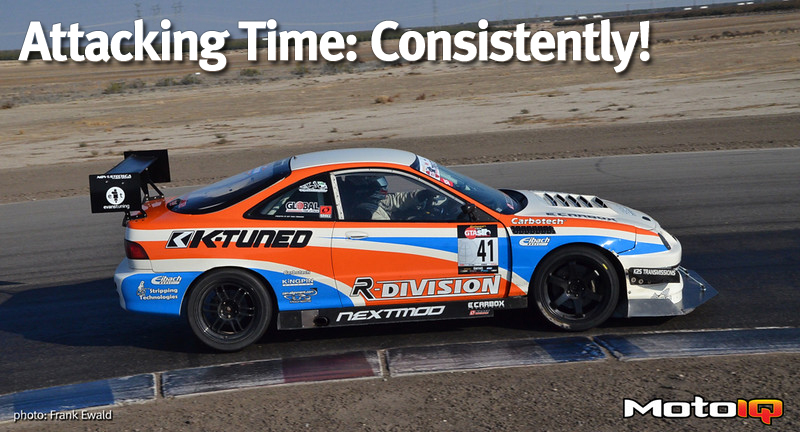,
 Huge thanks to Austin Cabot from TrackTuned.com for capturing this classic moment. There was too much wind resistance caused by the bolts supporting the splitter – so James ground them down! LOL! 2016's suspension system will eliminate this! Photo Credit: TrackTuned.
Huge thanks to Austin Cabot from TrackTuned.com for capturing this classic moment. There was too much wind resistance caused by the bolts supporting the splitter – so James ground them down! LOL! 2016's suspension system will eliminate this! Photo Credit: TrackTuned.The support bolts were grinding on the track under heavy braking and cornering, until they were virtually ground flat. Increasing spring rates helped a bit, but not enough.
 Coming through Cotton Corners after I-5, both right and left corners were hitting the track. Even increasing the spring rate on the first day didn't pull the front fully off of the track surface in hard cornering.
Coming through Cotton Corners after I-5, both right and left corners were hitting the track. Even increasing the spring rate on the first day didn't pull the front fully off of the track surface in hard cornering.In 2014 the first article about Jimmy's Type R graced the pages of MotoIQ (Attacking Time) and it has changed since then. Obviously, the livery has changed to reflect the colours of Vern Houghton Rustproofing – not only a sponsor but also his mom and dad. They are regulars at the track and in the paddock, however, the timing of Buttonwillow's race and the threat of snow in Ontario (Canada, not California!) kept them at home and running the family business. Rustproofing is always busy when the threat of snow … and salt … is in the air.
 The K-Tuned header is easily visible between the engine and the firewall. The Kraftwerks C38-91 Supercharger – well, it's tucked away but, believe me, it's there.
The K-Tuned header is easily visible between the engine and the firewall. The Kraftwerks C38-91 Supercharger – well, it's tucked away but, believe me, it's there.The winter of 2015 saw the following changes. The Kraftwerks C38-71 was replaced with the larger C38-91 supercharger that is making 20 pounds of boost. Translated into gearhead speak – about 575 whp and 375 ft/lbs of torque! The roll bar was enhanced and a full cage is now in place. Not only does this make me feel better, but it absolutely adds peace of mind for his mom, Diane. With more weight reduction taking place, the car now weighs 2275 pounds in race trim without driver.
 Carbotech XP20 brake pads coupled with the StopTech BBK haul the car down swiftly when necessary. Rear brake calipers are stock with Carbotech XP12 pads.
Carbotech XP20 brake pads coupled with the StopTech BBK haul the car down swiftly when necessary. Rear brake calipers are stock with Carbotech XP12 pads.The previous header was upgraded to a K-Tuned K24 race header, which is larger and has more flow than the previous generation. Wheels are Enkei RFP1 18×9.5 front and 17×8 rear. Tires are Hoosier A7 255/35/18 front and 225/45/17 rear. Suspension is an Eibach MultiPro R2 setup. Braking is provided by a Stoptech ST40 kit up front coupled with Carbotech XP20 brake pads. They also switched from using ethanol based fuel to using VP MS109 race gas.
 Looking through the rear window you can see the cage. In 2014 the half cage was installed. The full cage was put in place for the 2015 season. The rear window was recently coated in Buttonwillow sand. It gets everywhere!
Looking through the rear window you can see the cage. In 2014 the half cage was installed. The full cage was put in place for the 2015 season. The rear window was recently coated in Buttonwillow sand. It gets everywhere! Touching the apex will bring a puff of sand. To coat your window – that takes a bit more than a touch!
Touching the apex will bring a puff of sand. To coat your window – that takes a bit more than a touch!Over the last four seasons with CSCS the Integra has been unbeaten any time it has hit the track. In fact, car and driver have set track records at each of the last 14 events – many of them bettering his own record. CSCS introduced a new race segment this season called Max Attack. This allowed the Time Attack competitors to enter their cars in a No Contact sprint race – passing allowed. The intriguing twist on this is that the fastest cars were placed at the back of the grid and the slowest up front. Obviously, this made for a lot of action. In fields of ten to twenty cars, in which the Type R was always gridded at the back, James captured a third, a second, and two firsts.



